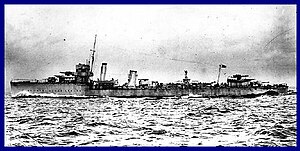HMS Vehement (1917)
 |
|
| History | |
|---|---|
|
|
|
| Name: | HMS Vehement |
| Namesake: | |
| Ordered: | July 1916 |
| Builder: | William Denny and Brothers, Dumbarton, Scotland |
| Laid down: | 25 September 1916 |
| Launched: | 6 July 1917 |
| Completed: | 1917 |
| Identification: |
|
| Fate: | Sunk 2 August 1918 |
| General characteristics | |
| Class and type: | Admiralty V-class destroyer |
| Displacement: | 1,272-1,339 tons |
| Length: | 300 ft (91.4 m) o/a, 312 ft (95.1 m) p/p |
| Beam: | 26 ft 9 in (8.2 m) |
| Draught: | 9 ft (2.7 m) standard, 11 ft 3 in (3.4 m) deep |
| Propulsion: |
|
| Speed: | 34 kt |
| Range: | 320-370 tons oil, 3,500 nmi at 15 kt, 900 nmi at 32 kt |
| Complement: | 110 |
| Armament: |
|
The first HMS Vehement was a V-class destroyer of the British Royal Navy that saw service in World War I. She spent her short career in minelaying operations in the North Sea before striking a mine and sinking in 1918.
Vehement was ordered in July 1916. She was laid down on 25 September 1916 by William Denny and Brothers at Dumbarton, Scotland, and, per a British Admiralty order of 12 January 1917, was fitted to carry 60 naval mines. She was launched on 6 July 1917 and was completed later in 1917 and commissioned into service. Her original pennant number, F1A, was changed to F12 in January 1918 and to H2A in June 1918.
Upon completion, V- and W-class destroyers, including Vehement, were assigned to the Grand Fleet or Harwich ForceVehement herself was assigned to the 20th Destroyer Flotilla in February 1918.
In 1918, the 20th Destroyer Flotilla was engaged in a major British effort to lay minefields in the North Sea to close the Heligoland Bight to passage by German ships and submarines. On 31 May 1918, Vehement put to sea from Immingham with the flotilla to lay mines in the Dogger Bank area. On the night of 4–5 June 1918, the flotilla again deployed from the Humber estuary to mine the same area, bringing the total number of mines laid in the two expeditions to 330.
...
Wikipedia
